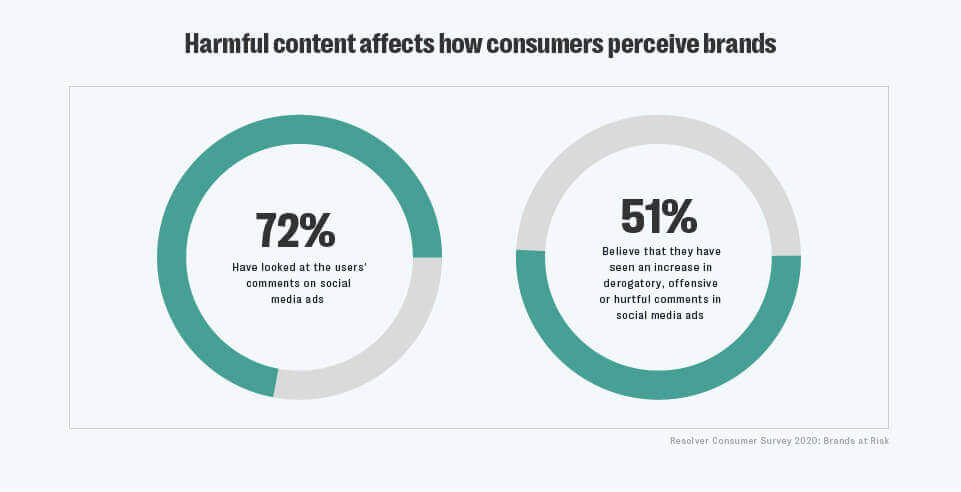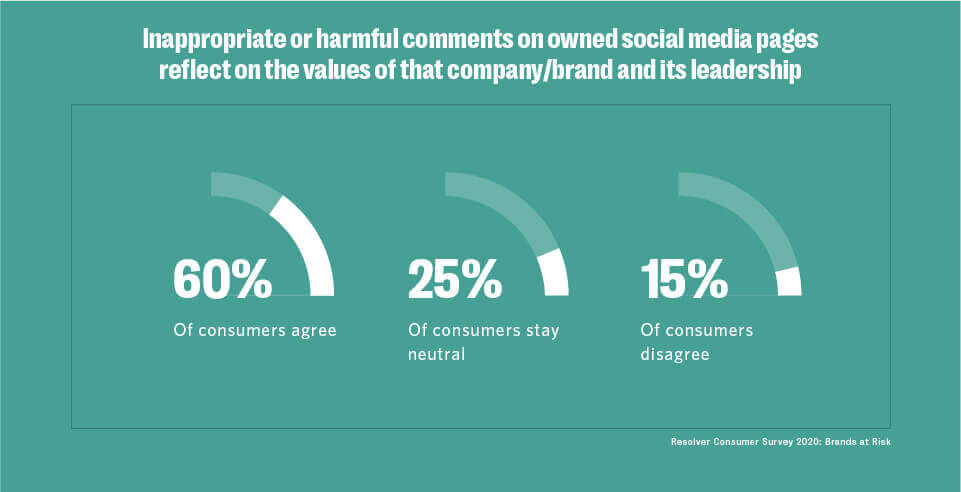It’s no secret that social media usage among consumers has increased, in some cases exponentially, since the beginning of the pandemic. As a result of COVID-19, people around the globe have been isolated from each other, compelling them to turn to online platforms for their social media interactions, and creating a surge in users and content.
Coupled with increased societal issues and the presence of instigators, such as trolls, harassers, activists, and sophisticated bad actors, this already-complex landscape has seen a boost in harmful and toxic content, creating a potentially disastrous scenario for brands.
Open the social media platform of your choice and you’ll find images of social justice movements, political divisiveness, and heartfelt commentary on how everyone is coping with the global pandemic. All of this content appears on the same social media platforms on which companies promote their sneakers, cars, pizza, and beauty products—often all merging together.
As this happens, brands work quickly to engage consumers and create empathetic and non-polarizing responses. Organizations are now forced to maneuver between engaging their audiences in a meaningful way, addressing the issues across their owned social media pages, and meeting the expectation of consumers within a highly connected society. As the spread of harmful content increases, so does the risk for brands.
To help brands figure all of this out, we surveyed 1,039 U.S. consumers to find out:
- How prevalent harmful content is in a consumers’ everyday life; and
- How harmful content on a brand’s social media ads affects consumer behavior.
The results will be concerning to every brand with a presence on social media, but there is something that can be done about it.
2020 requires brands to respond differently
There have always been instigators intent on spreading harmful content, misinformation, and product/service issues and complaints to sew discord and damage brands’ reputations. But, 2020 has delivered much more than anyone could have anticipated.
A global pandemic, racial injustice movements, the most divisive political landscape in modern history, and ongoing civil rights concerns have collided with customer care, competitor comments, and consumer complaints across digital channels, surging harmful online content and creating a unique risk landscape for brands.
The opportunities for growth through social media, as well as the expectations of consumers that brands engage in digital conversations, drive organizations to expand their online presence, which creates more risk and more exposure to harmful content.
Consumers also admit to sharing negative comments or content about a brand, only to find out later it’s untrue. This is one of several contributing factors to the reported 68% who said they have seen a significant rise in the frequency of negative comments on brand-owned social media pages.

Oftentimes, this harmful content shows up on the brand’s page, lending more credibility to negative comments, and causing more damage. This creates very real issues for brands participating online. Simply put, this is the brand’s responsibility.
Brand and consumer expectations don’t align
As brands expand their social media presence to reach new consumers, build awareness, and increase reputation and market share, they also are growing their social media advertising efforts.
With this growth comes an increase in negative or harmful content on those ads. While brands think they’ve responded to the comments appropriately, consumer expectations are high.
Nearly three quarters look at the comments on social media ads, and the reality is that those comments negatively influence their behavior. The comments, and the brand’s responses (or lack, thereof) change the way consumers engage with the content, which affects their purchase behaviors and the effectiveness of your advertising efforts.

If brands want to protect their advertising investment, they need to understand how this harmful content dilutes their advertising effectiveness, how it influences consumers’ purchasing behaviors, and how it is affecting their brand reputation.
What does this mean for your brand?
Many brands have underestimated how much harmful content resides on their owned social media pages and social media advertising campaigns and how it is hurting them. Simply put, inaction is no longer an option and brands need to address the problem. It has assaulted every aspect of digital marketing and communications, from consumer engagement to online storytelling and digital advertising campaigns.
Nearly two-thirds of respondents told us they are more likely to feel more skeptical towards organizations and their leadership as a result of the rise in false or harmful comments made online.

As well, 64% hold brands responsible for addressing inappropriate or harmful digital chatter on their owned social media pages. This issue sits firmly on the shoulders of the brands that engage online, and they need to act. Some consumers will give brands an hour to address inappropriate or harmful content on their pages, while others expect it to be taken care of instantly.
In 2020, the risks from harmful content have landed firmly at the doorstep of brands and it’s time to act, and act quickly. These risks need to be identified early, and the resulting incidents and issues need to be addressed instantly. Consumers demand it. Your business resilience will depend on it.
